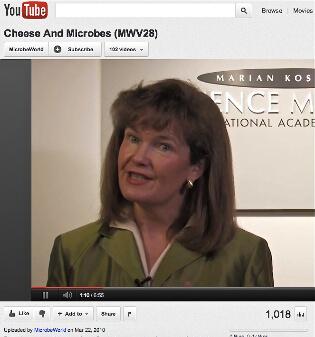Farmstead cheese is one of the great successes of 21st Century dairying. But last year, the cheese industry faced several recalls and multi-state E. coli outbreaks causing illness. Federal regulators are scrutinizing raw-milk cheesemakers with an eye toward unprecedented strict laws. Meanwhile, raw-milk cheesemakers and connoisseurs maintain that their practices are safe and the flavor of their cheeses is dependent upon unadulterated ingredients.
Refereeing this fierce debate with solid scientific data are University of Vermont research scientists at the Vermont Institute for Artisan Cheese (VIAC) – experts in cheese safety and food borne pathogens.
“I’m interested in making sure that we can forward traditional cheesemaking practices and ingredients in this era of food safety challenges,” co-director of VIAC, Catherine Donnelly said in a widely acclaimed video produced last year by the American Society for Microbiology.
“We found the absence of large-cheese-associated outbreaks to be remarkable, because compared with other commodities that's not the norm.” she says. “But in studies looking at instances where cheeses made from pasteurized milk were involved in outbreaks, we realize that the most significant threat to cheese safety isn’t the use of raw milk – isn’t the cheese itself – it's actually post-process recontamination either from the aging environment or introduction by humans of pathogens on their hands after the cheese is made. It's really recontamination that poses a threat. It’s irrelevant whether cheese is made with raw or pasteurized milk.” Donnelly is one of the nation’s foremost experts on microorganisms affecting food safety, especially Listeria.
She concludes that Staphylococcus aureus carried on human hands or cows’ udders causes the most problem in cheeses. Staph aureus allowed to grow to high population levels produces toxins that people sick. Listeria and Salmonella are sometimes also problematic as well as, though very rarely, E. coli.
Another problem that cheesemakers encounter are viruses that live in the cheesemaking environment, called bacteriophage that attack bacterial starter cultures and cause the batch to fail. Cheesemakers guard against bacteriophage by keeping the cheesemaking facility sanitary.
Donnelly’s $45,000, three-year Hatch grant was renewed and her USDA APHIS grants have totaled more than $600,000 over several years. These continue to pinpoint both the vulnerabilities in the large-commodity food system that contribute to the spread of pathogens while simultaneously demonstrating that centuries-old techniques used in artisan cheeses rely on the culture of beneficial microorganisms.
Donnelly believes that while regulation is one way to control food borne pathogens, education is another. VIAC teaches food-safety practices and past grants enabled her staff to do on-site risk-reduction programs for cheesemakers.
Donnelly and Dennis “DJ” D’Amico, a senior research scientist and lab manager for VIAC, are poised to use their scientific findings to continue to inform the Food and Drug Administration (FDA) and Health Canada as they evaluate the food safety of soft-ripened, raw-milk cheeses.
Donnelly and D’Amico predict that the debate among the interests of small and large-scale cheesemakers and the FDA will intensify in the coming year over a circa 1940s federal rule that requires cheese to be aged for 60 days before it is deemed safe to eat. The law was aimed at hard cheeses such as Cheddar that become inhospitable to pathogens as they dry out during aging. When raw-milk cheeses age, the chemicals, acids and salt in the cheese also destroy harmful bacteria, and since types of cheese differ greatly, scientists such as D’Amico and Donnelly conclude that the 60-day rule is simplistic at best.
“The 60-day rule wasn’t based on real science,” D’Amico told “The New York Times” last spring. “The pathogens have changed and the cheeses have certainly changed. But the rule has not.” D’Amico’s research was the subject of much media attention, also including the “Atlantic,” ABC and Fox News.
The FDA is reassessing the rule as it applies to soft cheeses, so the regulations are likely to change.
Expect the debate to heat up – but not the raw milk used in cheesemaking.
